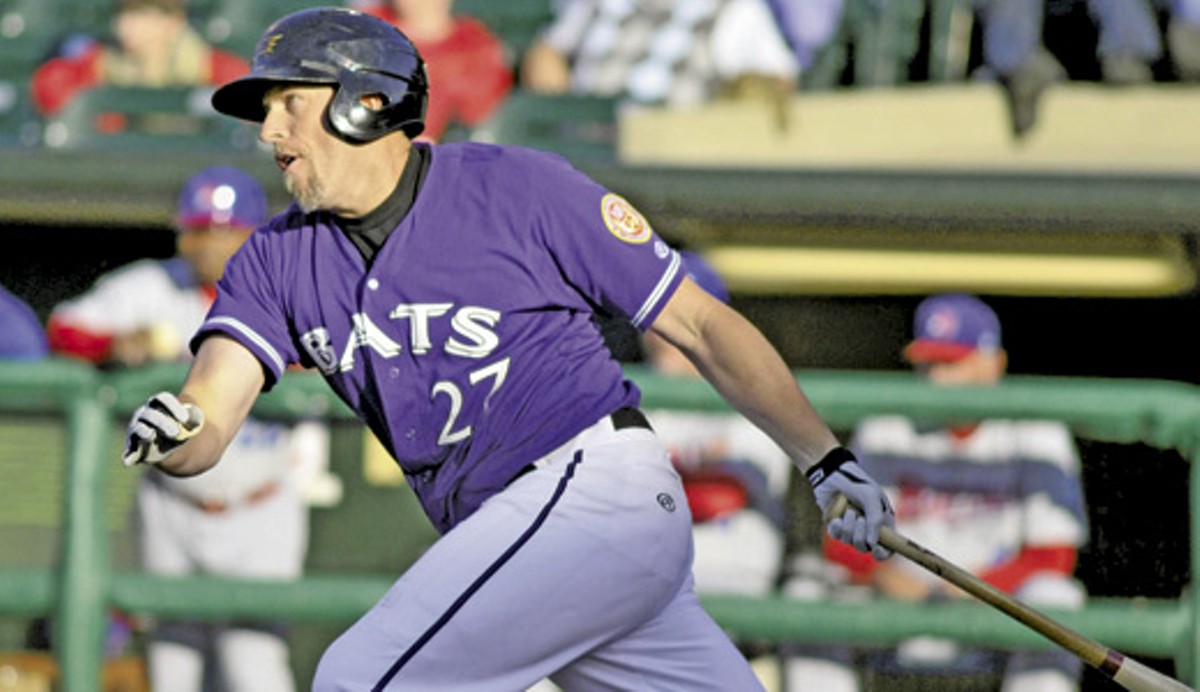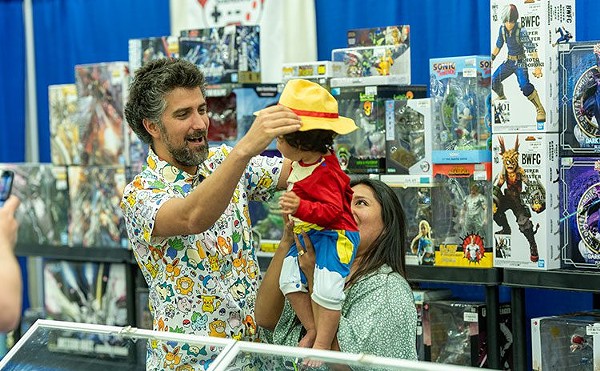Back 60 years ago, or so, Pittsburgh Pirates radio announcer A.K. “Rosey” Rosewell put the patent on one of baseball’s most colorful home run calls. When a Pirate hitter would sock one out of the park, Rosewall would call, “Open the window Aunt Minnie. Here comes another one!”
And with perfect timing, Rosewell’s KDKA radio broadcast partner Bob Prince would drop a box of broken glass and nuts and bolts: crash!
Time and television have pretty much relegated such radio booth histrionics to yesteryear, but the home run remains the big blast of baseball. From Little League to Big League, the round-tripper (big fly, tater, dinger, circuit clout, Herculean blast) still brings fans to their feet.
And now — after a few years without one — the Louisville Bats have a genuine home run king of their own in 6-foot-5 slugger Mike Hessman, the leading active home run hitter in minor league baseball.
Trim built and solid-muscled from high-knee stirrup socks to ridge-wide shoulders, Hessman looks the part of the home run ruler and has the numbers to prove it: When he hits his next one — which could come during an eight-game Bats home stand that begins Friday night at Slugger Field — he’ll have 400 home runs. Most important, he ranks third in home runs in the International League with 15, giving Louisville the big bat it needs.
“Being as tall as I am, I think my size gives me leverage,” Hessman says. “And leverage is more important than strength. I want to hit line drives and hit them hard.”
Two hours before game time, the first baseman steps into the batting cage to work on swing, timing and footwork.
“I’m not one of those guys that puts on a show in the batting cage — sit there and launch,” he says. “I’m working more on hitting hard line drives, and if I can hit them into the gaps and reach the walls in (batting practice), I know come game time some of those drives are going to go out of the yard for me.”
Standing outside the cage, awaiting his next swings, Hessman twirls his bat in one hand, then the other, warming up his wrists. When he steps in to hit, Hessman seems to be swinging down at the ball.
“You want to create some backspin on the ball,” he explains. “I’ve seen some drives where the outfielders start in on a ball and it carries over their heads. With the backspin it catches that little extra gear and takes off for you.”
Bats manager Jim Riggleman understands what Hessman is trying to do.
“There’s physics to it,” Riggleman says, taking a ball in one hand and a bat in the other. “If the center of the ball hits the center of the bat, it’s going to go straight. But there’s an area here (he moves the bat maybe 1/32 of an inch lower) where the ball is going to come off rotating this way, with backspin. If you get over it, the ball is going to rotate forward and tumble, and won’t carry. But if you get the backspin rotation, it’s going to lift.”
Riggleman spins the ball off the bat and it seems to catch an imaginary updraft, like wind lifting a wing.
“There’s different ways it’s taught,” Hessman says. “You hit down on it, cut and slice it. Like scaling a fish, where you’re scaling down — and boom! — you get that scale off the ball and get backspin. My thought process out here in batting practice is to concentrate hitting down at it, and later into the game when I straighten out my swing it’ll get that backspin for me.”
Who knew there was science to it?
Retired C-J baseball writer Ron Coons remembers that a sudden change came over slugger Ted Kluszewski when Rogers Hornsby took over as manager of the Cincinnati Reds in 1953. Hornsby had hit his way into the Hall of Fame as a player.
“When Klu came up he was a .300 hitter, but for his size and strength, he didn’t hit many home runs,” Coons says. “He had this big, sweeping swing. Then Hornsby became manager. Nobody knew what he taught Klu, but it was something; he suddenly hit over 40 home runs three years in a row. In 1954 he hit 49, and struck out only 35 times. Now that’s something!”
Beyond the stats
Jim Riggleman, of course, has experience managing premier home run hitters. He managed the Chicago Cubs in 1998 when Cubs star Sammy Sosa hooked up with St. Louis’ Mark McGwire in a home run chase — with both eventually surpassing Roger Maris’ 61-home run mark. McGwire hit 70 to set a new record. Sosa clubbed 66. Sammy also drove in 158 runs, the most RBIs in the National League in 68 years.
“It wasn’t like one day in May we knew Sammy was going to hit 60 home runs,” Riggleman says. “But then he hit 20 in June, and the chase was on.”
But Sosa provided more than homers.
“It was a special year in Chicago,” Riggleman says. “We were trying to get into the playoffs — and that was the focus for us, and for Sammy. One thing I remember is there were so many demands put on players for interviews, and so much of that was handled by Sammy. That allowed the other players to prepare and not get out of their routines — and we did get into the playoffs.”
Which is another way Hessman helps the Bats. Big league clubs often sign a seasoned player — a slick-fielding shortstop, a crafty reliever or a home run hitter — to a minor league roster so younger players can play with a winning team as they learn the game. And in this case, Hessman sets a standard of professionalism on the team.
“Four hundred home runs — that’s unbelievable,” Riggleman says. “And when your top players are professionals like Mike, the younger players would be ashamed of themselves if they didn’t play that way. Because here’s Mike Hessman, who’s always taking ground balls, never misses batting practice. He sets a standard. They have to be thinking, ‘If I’m 23, why can’t I be working like that? If the grind of a long season isn’t too much for him, at 35, why should it be too much for me?’”
Hessman is not a new face for Bats fans. A few seasons ago, when he was swatting 30 home runs a season with Toledo, Hessman would come to town and absolutely murder Bats pitching. Open the window Aunt Minnie, here comes another one!
“I’ve always liked it here,” the personable Californian says. “The ballpark and the fans are terrific ... and I’ve always hit well here.”
Hessman says he’s made contacts with baseball people about managing or coaching when his playing days are done.
“But I’m not ready for that yet — as long as I can still hit hard line drives and help the team.”
And wearing the home run king’s crown?
“I’ll admit,” he says, “trotting around the bases never gets old.”






